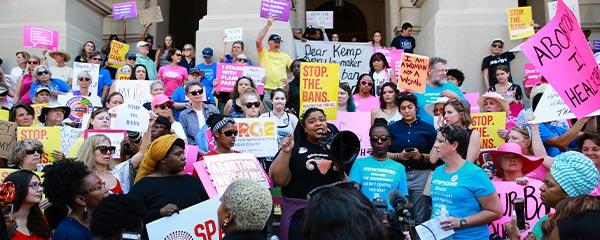PRINCETON, NJ -- The 41% of Americans who now identify themselves as "pro-choice" is down from 47% last July and is one percentage point below the previous record low in ÆéûÜǨû§trends, recorded in May 2009. Fifty percent now call themselves "pro-life," one point shy of the record high, also from May 2009.
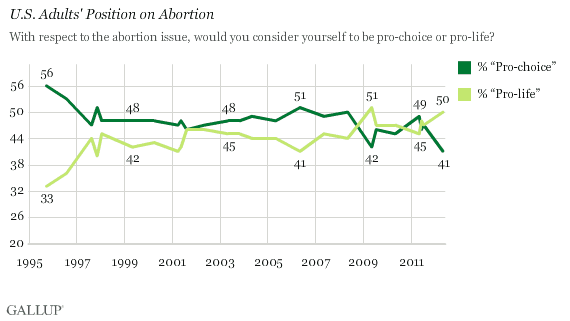
ÆéûÜǨû§began asking Americans to define themselves as pro-choice or pro-life on abortion in 1995, and since then, identification with the labels has shifted from a wide lead for the pro-choice position in the mid-1990s, to a generally narrower lead for "pro-choice" -- from 1998 through 2008 -- to a close division between the two positions since 2009. However, in the last period, ÆéûÜǨû§has found the pro-life position significantly ahead on two occasions, once in May 2009 and again today. It remains to be seen whether the pro-life spike found this month proves temporary, as it did in 2009, or is sustained for some period.
Decline in "Pro-Choice" Views Seen Across Partisan Groups
The decline in Americans' self-identification as "pro-choice" is seen across the three U.S. political groups.
Since 2001, the majority of Republicans have consistently taken the pro-life position, but by a gradually increasing margin over "pro-choice." That gap expanded further this year, with the percentage of Republicans identifying as pro-life increasing to 72% from 68% last May, and those identifying as pro-choice dropping to 22% from 28%. Still, Republicans' current views are similar to those found in 2009.
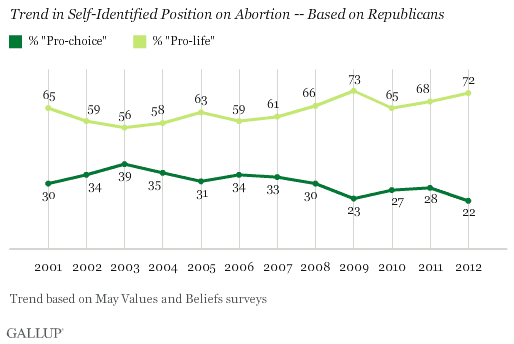
The percentage of political independents identifying as pro-choice is 10 points lower today than in May 2011, while the percentage pro-life is up by six points. As a result, pro-lifers now outnumber pro-choicers among this important swing political group for only the second time since 2001, with the first occurring in 2009.
More broadly, since 2009, independents have been fairly closely divided between the two abortion positions, whereas for most of the 2001-2008 period, significantly more independents were pro-choice than pro-life.

Democrats' views on abortion have changed the least over the past 12 years, with roughly 60% calling themselves pro-choice and about a third pro-life. Democrats' identification as pro-choice was above this range in May 2011, but has returned to about 60% in the current poll.
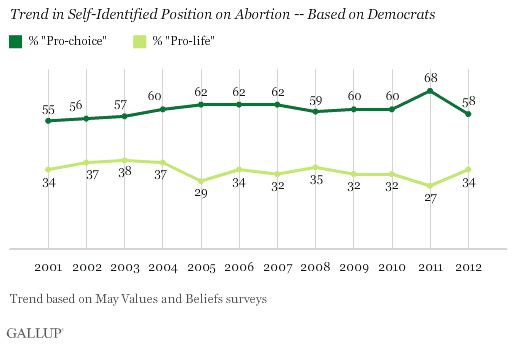
The shift in abortion views over the past year is not due to a change in the political composition of the samples. In the May 2-6, 2012, Values and Beliefs poll, 47% of respondents are Democrats or lean Democratic, while 41% are Republican or lean Republican. This is similar to the partisan composition of the May and July 2011 surveys, which showed a close division between pro-life and pro-choice Americans.
Views About Morality and Legality of Abortion Hold Steady
While Americans' identification as "pro-choice" has waned over the past year, their fundamental views about the and legality of abortion have held steady. Half of Americans, 51%, consider abortion morally wrong and 38% say it is morally acceptable -- nearly identical to the results in May 2011.
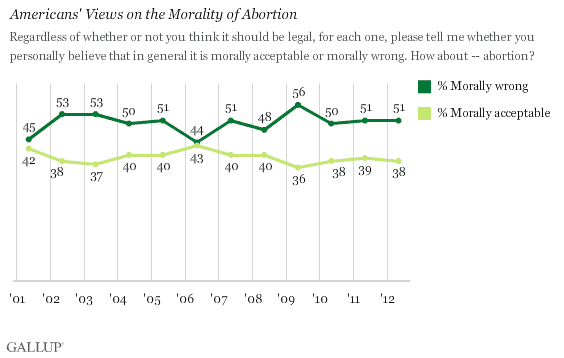
Gallup's , established in 1975, asks Americans if abortion should be legal in all circumstances, legal only under certain circumstances, or illegal in all circumstances. Since 2001, at least half of Americans have consistently chosen the middle position, saying abortion should be legal under certain circumstances, and the 52% saying this today is similar to the 50% in May 2011. The 25% currently wanting abortion to be legal in all cases and the 20% in favor of making it illegal in all cases are also similar to last year's findings.
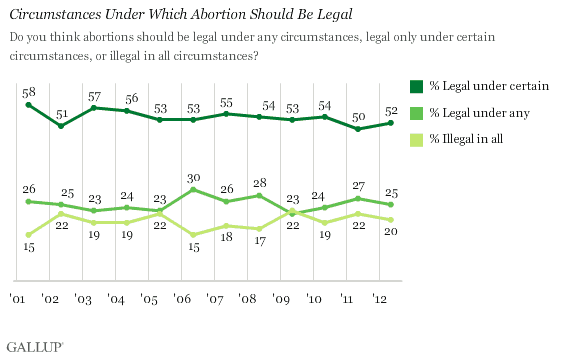
Bottom Line
Since 2009, Americans have been closely divided in their identification with the labels most commonly used by each side of the abortion debate, although twice in that time period, including today, the percentage identifying as pro-life has been significantly higher than the pro-choice percentage. This represents a clear shift from 2001 to 2008, when ÆéûÜǨû§most often found pro-choice adherents in the plurality.
Abortion has been the focal point of some prominent news stories in the past year, including congressional efforts to for Planned Parenthood because of its abortion services, as well as to investigate Planned Parenthood's financial practices. There was also a widely reported controversy over the Susan G. Komen for the Cure cancer foundation's temporary decision to suspend grants to Planned Parenthood pending the outcome of that congressional investigation. And the ongoing conflict between the U.S. Roman Catholic Church and the Obama administration over is partially related to abortion, in that the church contends that some forms of contraception can halt the development of a fertilized egg.
Whether any of these controversies is related to the shift in Americans' identification as pro-choice or pro-life is not clear. However, it is notable that while Americans' labeling of their position has changed, their fundamental views on the issue have not. If the advantage for the "pro-life" position persists in future ÆéûÜǨû§updates on abortion, these would seem to be important factors to look at to help explain the shift in labeling.
Upcoming ÆéûÜǨû§reports will explore Americans' 2012 views on abortion in greater depth, including looking at trends by gender, age, and other demographic variables.
Survey Methods
Results for this ÆéûÜǨû§poll are based on telephone interviews conducted May 3-6, 2012 with a random sample of 1,024 adults, aged 18 and older, living in all 50 U.S. states and the District of Columbia.
For results based on the total sample of national adults, one can say with 95% confidence that the maximum margin of sampling error is ôÝ4 percentage points.
Interviews are conducted with respondents on landline telephones and cellular phones, with interviews conducted in Spanish for respondents who are primarily Spanish-speaking. Each sample includes a minimum quota of 400 cell phone respondents and 600 landline respondents per 1,000 national adults, with additional minimum quotas among landline respondents by region. Landline telephone numbers are chosen at random among listed telephone numbers. Cell phone numbers are selected using random-digit-dial methods. Landline respondents are chosen at random within each household on the basis of which member had the most recent birthday.
Samples are weighted by gender, age, race, Hispanic ethnicity, education, region, adults in the household, and phone status (cell phone only/landline only/both, cell phone mostly, and having an unlisted landline number). Demographic weighting targets are based on the March 2011 Current Population Survey figures for the aged 18 and older non-institutionalized population living in U.S. telephone households. All reported margins of sampling error include the computed design effects for weighting and sample design.
In addition to sampling error, question wording and practical difficulties in conducting surveys can introduce error or bias into the findings of public opinion polls.
View methodology, full question results, and trend data.
For more details on Gallup's polling methodology, visit .
